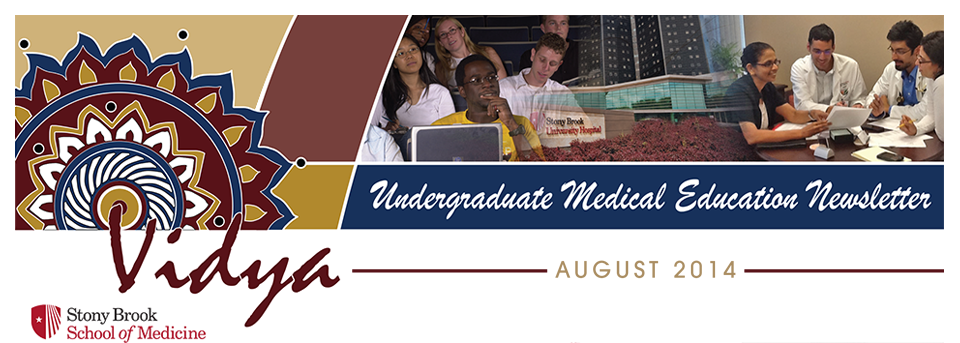| Download PDF Version |
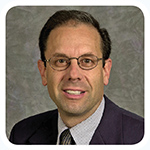
On August 18th, 2014, the class of 2018 was introduced to our revised curriculum, entitled the LEARN Curriculum. The LEARN Curriculum is the product of an initiative starting in the spring of 2011 by over one hundred faculty, students, and administrators at Stony Brook University School of Medicine working in specific subcommittees. Among our goals in introducing the reformed curriculum was our interest in increasing active learning, establishing early professional identity, and developing physician competencies in an integrated and contextual approach. The guiding principles for LEARN approved by our Curriculum Committee included a focus on active student learning, on students having responsibility to LEARN with faculty serving as facilitators, interdisciplinary integration of curricular content and earlier introduction of the clinical clerkships. The LEARN curricular model was approved by the Curriculum Committee after an eighteen month planning period.
LEARN is an acronym for learning Centered, Experiential, Adaptive, Rigorous and Novel. The LEARN curriculum is divided into three Phases: an eighteen month foundational phase, a one year primary clinical phase and a sixteen month advanced clinical phase. Five themes run throughout the three phases of the curriculum.
- patient and family-centered care,
- evidence-based care,
- patient safety and quality care,
- ethical and professional care, and
- health promotion and preventive care.
Several innovative features have been incorporated into the LEARN curriculum. These include transition courses at the beginning of each phase of the curriculum, Translational Pillars throughout the clinical phases of the curriculum and the introduction of Stony Brook Teaching Families.The Transition courses provide training as students move from one phase to another. The Transition to Medical School at the start of phase one enables students to begin to understand the roles, responsibilities, expectations, and values of the medical profession. The Transition to Clinical Care course precedes the students’ entry into the clinical clerkships and enables students to LEARN their roles and responsibilities within the complex world of inter-professional care teams in in-patient and out-patient settings. The Transition to Residency is a course in the fourth year of the curriculum which prepares our students for the skills they will need to begin their internship following graduation. Another innovation in our LEARN curriculum is the implementation of Translational Pillars. Translational Pillars take place at defined intervals throughout the clinical phases. The educational goals of the Translational Pillars are to provide integration along the continuum of basic biomedical sciences to translational sciences to clinical sciences. The topics for the Translational Pillars will cut across all medical specialties and focus on current and emerging topics in the biomedical sciences that will have an impact in the clinical environment. Some examples of Translational Pillar topics include medical genetics, cancer biology, microbial pathogenesis, and metabolic diseases. The Stony Brook Teaching Families are virtual families that have been created by interdisciplinary teams of faculty to assist and enrich the curriculum. These families will visit the students throughout each phase of the curriculum.
Other components of the LEARN curriculum reflect recent and ongoing activities. During the most recent academic year, we instituted Longitudinal learning Communities. These groups meet once a month in a social environment where faculty facilitators provide advice, guidance, and mentorship to students. In the LEARN curriculum, the Longitudinal learning Communities will additionally serve as a venue for the development of peer assessment and feedback skills. Our Scholarly Concentrations Program is an optional activity in which many of our students participate. Five distinct tracks exist that span the interests of our students and their faculty mentors. These tracks include basic, clinical or translational research, global health, social sciences, medical humanities and ethics, and medical education. Students spend at least six months involved in their area of scholarly activity culminating with a presentation of their work through a poster session or oral presentations on Research Day in their fourth year.
Phase one of the LEARN curriculum begins in August of the first academic year and runs through February of the second academic year. It begins with the Transition to Medical School course followed by a new course, Biomedical Building Blocks, a six month foundational course comprised of four components, The Body (anatomy), Molecular Foundations of Medicine (biochemistry; cellular biology and physiology; and pharmacologic principles), Pathogens and Host Defense (integrating immunology, inflammation, microbiology and immunologic diseases), and Basic Mechanisms of Disease (integrating histology, general pathology, hematologic and neoplastic diseases, and dermatologic diseases). The second part of phase one includes several integrated organ physiology courses: cardiovascular, pulmonary and renal systems, gastrointestinal system, the endocrine and reproductive system, and a newly created course, Mind, Brain and Behavior (which integrates fundamental neuroanatomy and neuroscience with neuropathology and psychiatric disorders). Physiology and Pharmacology are integrated throughout Phase one.
Three additional courses run throughout Phase one. Themes in Medical Education are week-long units that bridge key content across the curriculum. These week-long units will have a patient focus within an active learning environment. The two other courses run longitudinally throughout Phase one. Introduction to Clinical Medicine introduces patient-based skills (history and physical exam) and Medicine in Contemporary Society introduces students to ethical and social issues in current health care.
Phase two of the LEARN curriculum is the primary clinical experience and runs for twelve months. This phase includes all of the clinical clerkships. The clerkships are periodically capped by the one-week Translational Pillars.
Phase three is an advanced clinical phase that runs sixteen months. Included in Phase three are sub-internships, clinical electives, the Transition to Residency course, and a specialized Advance Clinical Experience in selected areas of medicine.
We believe that our new LEARN curriculum will provide an enriching and active environment for medical education that will train our medical students to become life-long Learners with the knowledge, skills and attitudes to work effectively in complex inter-professional health care teams and activities.

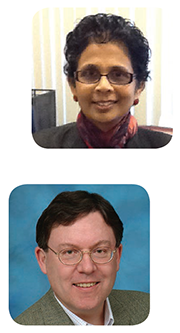
One of the key themes across the new LEARN curriculum is “patient- and family-centered care.” Our new curriculum introduces our students to five fictional families in which members manifest various diseases and a wide range of illness experiences in contemporary societal contexts. The idea here is to promote the development of student competencies required for success as physicians providing care for such families in the real world, integrating biological and behavioral sciences in a community context. We do not want students to think of patients in purely biological and objective terms. We want them to think deeply about the patient as a person and as a person-in-a-family, within a dynamic and complex community. At this interface we see the convergence of science, evidence-based medicine, relational skill sets, clarity of communication in an increasingly pluralistic and cosmopolitan hospital setting, ethical decision-making, empathic and compassionate care, and cultural sensitivity. Why is this convergence so important to medical education today?
These days a quick scan of the internet indicates that there are annual mega-conferences focused on this topic, and a highly regarded Institute For Patient- and Family-Centered Care (www.ipfcc.org). Every clinician knows that when they interact with a patient, that are overtly or tacitly interacting with the patient-in-the-family. While family practice is a medical specialty, the principles of patient- and family-centered care are relevant across all medical specialties and disciplines.
The institutions of healthcare and the family are interwoven in countless ways. Some of this has to do with rapidly evolving technologies. For example, advances in organ transplantation have created a whole new set of expectations that family members will be willing organ donors, or that a child can even be conceived in part as a “savior sibling” for bone-marrow transplant as parental love and science converge in the effort to treat a child with Diamond Blackfan anemia. Medical social workers in transplant clinics are careful to take an adolescent kidney donor aside and ask him or her if they really want to be a donor for their brother or sister or not, and if not, this has to be explained to the family with care. Perhaps we assume too much kin altruism as medicine offers these leading edge therapies?
Or the case Jane, a 40-year-old woman who has diagnosed with stage IIA breast cancer. She was seen for genetic counseling for BRCA1 and 2 testing. The genetic counselor explained what BRCA1/2 genes are and how genes are inherited. Jane decided to pursue the testing, and discovered that her genetic test for BRCA2 had come back positive. The counselor noted that Jane is at increased risk for a secondary breast cancer as well as ovarian cancer, melanoma, and some GI cancers. She has two teenage daughters and two sisters in their late 30s. Because Jane was found to have a mutation known to cause breast cancer, other relatives in her family could now be tested for the same mutation. With the help of the counseling team, Jane drafted a letter to send to all of her at risk family members. The letter discussed the family’s increased risk for breast and other cancers and indicated that testing was available. Contact numbers for Jane and the cancer genetics clinic were also included.
Or take David, a 17- year-old male who has not been acting himself lately. His teachers noticed that his grades were slipping, he didn’t seem to be concentrating as well and he was falling asleep in class. One of his teachers sent a letter home to his parents notifying them of his behavior changes and recommending that he see a psychiatrist. During a therapy session, Brian started crying and told the therapist that he was attracted to guys but didn’t know how to tell his parents or his friends. He had considered trying marijuana because the alcohol wasn’t having the same effect that it used to have. He also said that he’d thought about killing himself lately. How does the pediatric psychiatrist engage Brian’s family in this challenging circumstance?
Beyond such powerful cases, we want our students to think broadly about patients, families, and the healthcare they provide. How can we establish mutually beneficial partnerships among providers, patients, and families? How can we best recognize and support families in the vital roles that they take on in the care of infants, children, adolescents, the “differently abled,” and frail older adults with chronic conditions? What costs are involved for families at the financial and emotional levels, and how can these costs be ameliorated? How can we communicate effectively with patients and families from many different cultures, some of whom have long traditions of familial or patriarchal decision-making and little or no concept of the family member as an autonomous individual? How can we properly engages families in difficult end-of-life medical decisions and in palliative care or hospice care? How does a clinician navigate intense disagreements with the family proxy decision-maker who insists on continued treatments that the healthcare team considers to be medically “futile”? Where does an understanding of family culture and spirituality fit in? How does patient confidentiality operationalize in a case where there are absolutely no secrets between family members? And what, after all, is a “family” legally and socially? What does it look like when a hospital makes a serious commitment to patient- and family-centered care both socially and even architecturally?
Our experiment with the patient-in-the-family is an innovation whose time has come, and we plan to keep our readers updated. We will select “student tracers” who will help guide the process of optimally integrating these five initial Stony Brook Teaching families into our LEARN curriculum. We also welcome any additional suggestions about how, where and when to interweave this theme into the medical school curriculum.
Across the country, medical students are increasingly recognizing the added value of obtaining a joint degree in a related discipline while studying medicine, most commonly this is a Masters in Public Health [MPH]. The MPH provides a background and skills, which are valuable to those who anticipate careers involving administration; populations based research or public service related to health care. In addition, the MPH is a valuable credential, which enhances career advancement at all stages of development, including residency selection. At Stony Brook, a revised MD/MPH program has been developed to coordinate with the new medical curriculum. The recommended plan is a 5-year experience with the MPH year taken between phases two and three of the MD curriculum. This allows for a very small number of MPH courses, which need to be taken concurrent with MD courses. Other programs can be tailored to meet individual student’s needs.
For information contact: The MPH Academic Coordinator at Joanmarie.maniaci@stonybrook.edu.
Recent Stony Brook Md/Mph Graduates heading to these residencies:
• Duke for Cardiothoracic Surgery
• Massachusetts General Hospital for Internal Medicine
• Columbia for Pediatrics
Quotes from our graduates:
It was challenging but in the end, I saw the benefits of my public health degree as a resident in pediatrics. I was surprised how much I was able to navigate and utilize the literature for the patients I took care of and how much I participated in journal clubs during my training. My concentration in Evaluative Sciences allowed me to take part in research and quality improvement projects and I’ve presented at a number of conferences. Since graduating from the School of Medicine and Graduate Program in Public Health, I’ve completed my Pediatrics Residency at the Children’s Hospital of Pittsburgh of UPMC and I am now a 3rd year Pediatric Cardiology Fellow at The Children’s Hospital of Philadelphia.
- Shaun Mohan, Class of 2009
I believe getting my MPH at Stony Brook while doing my MD was one of the best decisions I’ve ever made. It really opened my eyes to a more global and community perspective in health, rather than the individual perspective we get in medical school. I enjoyed all of my classes and meeting a variety of people in the MPH program. It’s influenced me in my pediatric residency training, and has inspired me to pursue my pediatric infectious disease research in public health and vaccinology at the CDC.
- Lakshmi Sukumaran, Class of 2009

Perhaps the most fulfilling part of attending medical school was the ability to participate in a team focused on helping ill people heal. However, it became very apparent during my medical school training that there remains a vast amount of knowledge about disease and optimal treatment of disease that we still do not know. Clinicians dealing with patients on a day-to-day basis are uniquely positioned to help shed light on some of these gaps of knowledge through research. In particular, I was very interested in better understanding the factors that influence patients’ quality of life. Luckily, SBMED had a program just for that, the Scholarly Concentration Program (formerly known as the MD with Recognition in Research). During my first year of medical school, I found a mentor, Dr. Laurie Shroyer, who was also interested in that same topic. In fact, she was researching that topic in patients that underwent Coronary Artery Bypass Grafting (CABG). Given my career aspirations in Cardiothoracic Surgery, it was a terrific match-up.
During the spring of my first year of medical school, I started working on paperwork to secure a VA research appointment (given that my research was going to be exclusively on Veterans receiving CABG), as well as other paperwork and IRB approvals. During the summer between my first and second year, I was fortunate enough to have been selected for a summer stipend through the School of Medicine, which helped me pay for housing and other living expenses, which meant most of my time was dedicated to my research project. On a daily basis during that summer, I worked one on one with my mentor, Dr. Shroyer, and other team members involved in the project. It was a learning experience that perhaps was one of the most valuable in medical school. It was as close to a modern day master-apprentice model as one can get. Dr. Shroyer involved me in all aspects of the research, from taking lead on the literature searches, organizing the analysis, coordinating authorship calls and meetings, and finally, drafting and editing the final product. What was perhaps the most invaluable is the one on one relationship that I developed with my mentor with the project. It was learning at my own speed that was focused on my interests. By the end of the summer, I had my first rough draft of the manuscript…but I knew there was much work to be done.
With the start of the second year of medical school, there was very little free time to dedicate to research. However, whenever I got a chance, I would revisit the project. During the year, I worked on updating the draft, running some new sensitivity analysis with the statistician, and also equally as exciting, applying and being awarded an AMA-Medical Student Research Grant. I did that with the help of my mentor given some interesting findings that we saw during the summer from the project.
During my third year of medical school, I was able to take a month long research elective early on in the year to continue working on my project. That month was critical in finalizing the manuscript and submitting it for publications. During the year, and in between clerkships, I worked on revising the manuscript per the reviewer’s comments. Finally, towards the end of the year, I got notice that my project was accepted for publication in the Annals of Thoracic Surgery, the official journal for the Society of Thoracic Surgeons! In fact, it was designated as a “CME” article. The original article sits in a wood frame (a gift from my mentor) hanging in my living room. While the eventual publication of the work might signal the end, I was not done with the topic yet. The research has actually led to a number of new questions that I wanted to further explore. Given the flexibility of the 4th year of medical school, I quickly signed up for 4 additional months of research time. During that time, and in between interviews, I continued to explore those questions.
Participating in the Scholarly Concentration Program was perhaps one of the most fulfilling experiences of medical school. It was the ability to research a topic that was of great interest to me, to do it as part of a dedicated and highly valuable one-on-one mentorship relationship with an outstanding established scientist, and finally the ability to take ownership in contributing, even a small amount of new knowledge to a field that I feel passionate about.
The Scholarly Concentrations Program is a four-year track opportunity for medical students to engage in and attain recognition for scholarly pursuits in related areas of medicine. Under this Program, students have the opportunity to do academic exploration in Basic Sciences, Translational Research, Global Health, Medical Education, Social Science or Medical Humanities & Ethics. The program aims to align the areas of interest of students with the academic mission of the School providing a longitudinal area of work to the student experience at the School of Medicine. For many students, this period has been extremely helpful in shaping career goals and in building an academic track record attractive to residencies. The specific goals of the Scholarly Concentrations Program are:
- To provide encouragement, impetus, and support for engaging in additional extracurricular scholarly pursuits aligned with one’s own area of interest
- To facilitate the attainment of valuable career experience in areas and projects related to medicine as a complement to students’ didactic medical education.
- To provide special recognition to students who engage in such scholarly pursuits and meet the standard requirements of the program.
“Effective teamwork is necessary to achieve the Institute of Medicine competencies for care that is safe, timely, effective, efficient, and equitable. Introduction to the roles, responsibilities, and contributions of individual team members early in professional development is critical to fully embracing the value that teamwork adds to patient care outcomes.” – Association of American Medical Colleges.
The AAMC has articulated 13 Core Entrustable Professional Activities (EPAs) that all medical school graduates ought to be entrusted to perform upon entering their first year of residency. A medical professional is considered entrustable when s/he is able to perform a task or responsibility unsupervised. EPA 9 focuses on effective teamwork. More specifically, inter-professional teamwork.
Why is effective teamwork a core entrustable professional activity that all medical students must become proficient in by the time they graduate from medical school? A look at two of our SOM course descriptions provides some insight. The description for a fourth-year elective in Trauma Surgery states, “The student will demonstrate an ability to integrate into a multidisciplinary trauma team to provide timely and efficient care.” That for a Geriatrics elective states, “Students will develop a preliminary management plan for patients presenting with functional deficits, including adaptive interventions and involvement of interdisciplinary team members from appropriate disciplines, such as social work, nursing, rehabilitation, nutrition, and pharmacy.” You might be tempted to question the concordance between what is written in a medical school course description and the practice of medicine in the real world. During a panel discussion on a complex ob/gyn-cardiology case presented to new medical students in our Transition to Medical School course Dr. Ruth Wei commented, “In medicine we are not our own island; we must work as a team.” The outcomes of that case highlight why this is so: the young, pregnant mother of two underwent successful cardiothoracic surgery for the removal of a mass in the left atrium of her heart during her 27th week. She eventually gave birth to a healthy, full-term baby. Ultimately, as this case shows, effective teamwork among health care professionals comes down to improved patient care and improved patient outcomes.
Yet effective teamwork transcends the clinical environment. August 18, 2014 marks the launch of our new LEARN curriculum. LEARN is an acronym for Learning-focused, Experiential, Adaptive, Rigorous and Novel. The focus of the LEARN curriculum is on student-centered learning, integrated basic and clinical sciences, interdisciplinary and inter-professional teamwork, and peer feedback. Note the key words: integrated, interdisciplinary, inter-professional, peer feedback. In sum, the new LEARN curriculum is all about teamwork. Furthermore, LEARN is more than just student teamwork. The LEARN curriculum would not have made it to launch day without a tremendous amount of teamwork on the part of hundreds of faculty, administrators, professional staff, support staff and students that began in 2010. Nor will this teamwork end come August 18th. Effective teamwork is an ongoing process towards reaching shared goals. For deeper insight into the development, design, implementation, and ongoing evaluation and refinement of the LEARN curriculum, check out the Curricular Reform at the SOM website http://medicine.stonybrookmedicine.edu/LEARNcurr.
In LEARNing and in LIFE, it’s all about teamwork!
MD/PhD: The MSTP, or Medical Scientist Training program, enables students to complete a PhD and an MD as part of a joint degree program. Students start medical school and complete the first two years and their USMLE Step 1 licensing exam before beginning their PhD research. Students often take 3 to 5 years to complete their PhD, after which they return to the clinical years of medical school. Students have opportunities to present their work at “Research Days” at the university or at national or regional conferences. They work with scientists at Brookhaven National Laboratory and Cold Spring Harbor Laboratory. The MSTP website states, “Graduates of this program are equipped to study major medical problems at the basic level, and at the same time, to recognize the clinical significance of their discoveries.” You can find more information at this website: http://www.pharm.stonybrook.edu/mstp/.
MD/MBA: For the MD/MBA, the students apply to the School of Medicine and indicate that they are interested in the MBA program. They are accepted to the School of Medicine first, followed by acceptance to the School of Business. The MBA is 48 credits consisting of 16 courses. Students can take most of the MBA before starting medical school or after completing their medical degree. Some students opt to take a year off from medical school to complete the bulk of their MBA courses. Ethics and Law, and an Industry Project offer credit in both the MD and MBA programs. You can find more information at this website: http://www.stonybrook.edu/commcms/business/mba/md_mba.html.
MD/MPH: The MPH Program advocates a population health approach to public health. The hallmarks of population health are an ecological understanding of the determinants of health and a systems approach to solving health problems; emphasis on proactively stabilizing and improving health among all populations; and insistence on accountability, evidence-based practice, and continuous performance improvement.” The program focuses on developing public health leaders who will make an impact on society. Students in theMD/MPH program can take Global Health, Epidemiology, and Biostatistics courses in the MPH program and receive up to 12 elective credit weeks in medical school. You can find more information at this website: http://www.stonybrookmedicalcenter.org/gpph/career.
MD/MA: The Center for Medical Humanities, Compassionate Care, and Bioethics offers, on a selective basis, the opportunity for up to two medical students a year to enter our joint MD/MA program. These students must (1) enroll in the Schools of Medicine’s MD with Scholarly Concentration in the Medical Humanities and Bioethics Track in the second semester of their first year, (2) take six 3-credit graduate courses from our MA program, and (3) successfully complete the Medicine in Contemporary Society program that is part of the required medical school curriculum. These requirements can be met comfortably within the four-year window of medical school, allowing students to receive both the MD and MA degrees upon graduation. MA tuition is waived for medical students, who should apply at or before the start of their first year. Those students wishing to apply should contact Stephen G. Post, PhD, Program Director (Stephen.Post@StonyBrookMedicine.edu), and copy Michael Ortega (michael.ortega@stonybrookmedicine.edu) for information on the application process.

|
Undergraduate
Medical Education Deans |
|
Latha Chandran, M.D., M.P.H.
|
|
Grace Agnetti, M.S. Ed
|
|
Mary Jean Allen
|
|
Howard B. Fleit, Ph.D.
|
|
Jack Fuhrer, M.D.
|
|
Aldustus E. Jordan III, Ed.D.
|
|
Andrew Wackett, M.D.
|
Richard J. (Rick) Iuli, Ph.D.
|
|
Wei-Hsin Lu, Ph.D.
|
|
Caroline R. Lazzaruolo
|
|
Nancy Acevedo, Office of Admissions
|
|
Bonnie Chalson, Office of UGME
|
|
Ann Dowsey, Office of UGME
|
|
Donna Kaufman, Office of UGME
|
Rhonda Kearns, Office of UGME
|
|
Maria Heifferon, Office of Admissions
|
|
Fabiola Moraes-Narvaez, Office of Admissions
|
|
Diane Piscitelli, Office of Student Affairs
|
|
Lorraine Reeve, Office of UGME
|
|
Dianne Tokar, Office of UGME
|
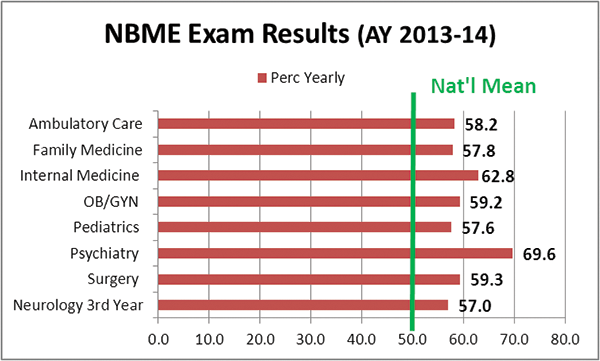

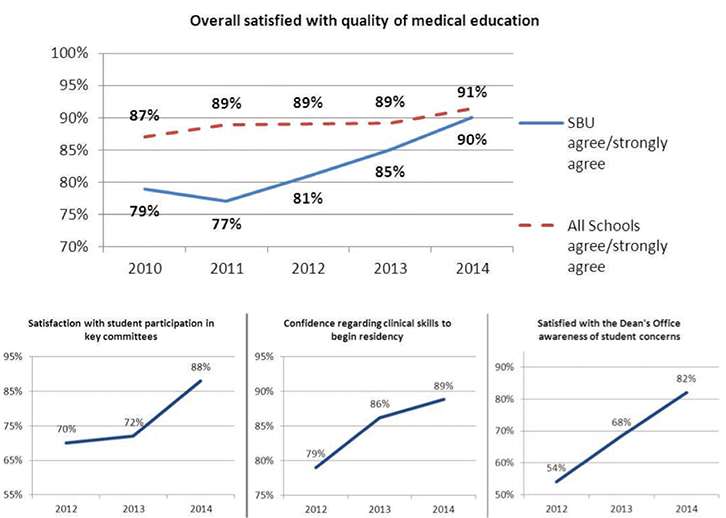
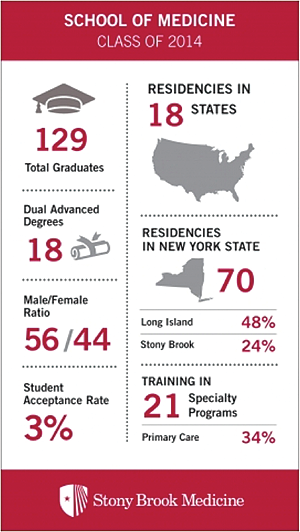
Our students are well represented on our School Committees. Feel free to talk to your committee representatives to find out what’s going on regarding policy, curriculum, and other important committees. See if you can participate and help!
Committee on Academic Professional Progress:
Edward Amador, Jay Chudow, Daniel Talmasov
Honor Code:
Eric Roth, Naureen Osman, Leena Shah, Anke Ziegenbalg, Nick Schwartz, Debbie Lee, Ashwin Maalhotra, Jay Chudow, Richard Efem, Justin Mathew, Jasin Lai, Daniel Talmasov
Curriculum Committee:
George Taylor, Alex Gauger, Arjun Iyer
Student Finance Committee:
Brent Penque, Karen Tsai, Young Jin Kim, John Mattimore, Himanshu Sharma
| TGIF: Read your TGIF emails from the UME office every Friday. Get news, important scheduling information, research and elective opportunities, etc. | |
| Student Activities in 2014-15: | |
| First Year Orientation | August 15 |
| LEARN Curriculum Kickoff - Phase 1 | August 18 |
| Transition to Medical School | August 18 -29 |
| Second Year Welcome Back | August 18 |
| White Coat Ceremony | August 29 |
| Global Medicine Info Session | September 22 |
| Hispanic Heritage Event | Tentative - October 17 |
| Global Medicine Info Session | October 20 |
| Careers in Medicine | October 29 |
| Scholarly Concentrations Info Session | November 20 |
| International Research Fellowship Info Session | November 21 |
| Year 3 Intersession | December 15-19 |
| International Research Fellowship Info Session | January 12 |
| Diaspora of Color | Tentative - February 6 |
| Asian Extravaganza | Tentative - March 6 |
| Careers in Medicine | March 12 |
| Match Day | March 20 |
| Evening of Art | Tentative - April 3 |
| Pot Luck Dinner | To be determined |
| Research Day-SCP presentations | April 29 |
| Commencement | May 21 |
| Year Three Orientation Week | June 29 - July 3 |
| Also check the School’s Academic Calendar at: https://cbase.som.sunysb.edu/conet/calendar/stud_mainFrame.cfm?school=Medicine |
|
The two-week Communicating Science to the Public elective is a series of seminars and workshops for medical, nursing and dental students who want to communicate more effectively about health science with patients, the public, public officials, the media, etc. Directed by Evonne Kaplan-Liss, M.D., M.P.H., (evonne.kaplan-liss@stonybrook.edu) with guest lecturers from the Alan Alda Center for Communicating Science & Stony Brook School of Journalism. At the conclusion of this course, students will be able to speak clearly and vividly about science in ways a lay audience can understand the appreciate; connect with an audience, colleagues, patients, friends, or any partners in communicating in a spontaneous, direct, personal and responsive way; use communication techniques that incorporate cultural competency and health literacy concepts to reach and mobilize the community and key stakeholders on health-related issues. Tentative dates for the Spring term are: 3/23, 3/30, 4/13, 4/27, 5/4, 5/11. Time: 4-7 pm. Please use a Drop/Add form and bring to Bonnie Chalson.
The Rising Leaders in Health Care two-week elective begins in November. The core goals are: Gaining real-world, applicable skills; Enhancing professional networks; Building community relationships; Expanding cultural awareness; Evaluating healthcare industry efficiency and effectiveness; Improving the quality of patient care. Please sign up with a Drop/Add form if you would like to add the class for credit and submit form to Bonnie Chalson. Course primary contact: latha.chandran@stonybrookmedicine.edu.
Global Health is a one-week elective taken by year 1 & 2 students during the fall semester; lectures will be held on Tuesdays from 4-5:30 pm. This course provides an introduction to the field of global health and challenges students to think about how a global perspective could enhance your future practice. The first half of the semester will provide an introduction to some core concepts in global health, including its definition and origin; how to measure the global burden of disease; recent progress and current challenges; social inequalities in health; health systems; and global stakeholders. The second half of the semester will narrow in on major global health topics, including child health and immunization, infection disease epidemiology, chronic disease epidemiology and sexual violence. NOTE: This elective is required for students enrolling in the Scholarly Concentration Global Health Track. Course Primary Contact: David.Graham@stonybrookmedicine.edu
| Download PDF Version |


